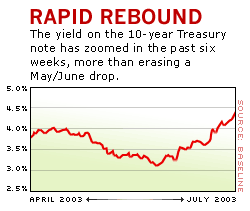NEW YORK (CNN/Money) - Though U.S. interest rates continue to rise, throwing cold water on the red-hot housing and mortgage-refinancing markets, most economists still believe they will not douse a recovery in the broader economy.
Not yet, anyway.
Treasury bond prices sank Tuesday, and their yields, which move opposite to price, soared -- the interest rate on the 10-year note, which forms the basis of 30-year mortgage rates, shot up to 4.45 percent, a 12-month high.

Though the 10-year note rate fell back a bit Wednesday, it's still at its highest level since last August and a whopping 1.3 percentage points higher than its 45-year low touched in mid-June.
The impact of higher rates has already shown up in mortgage activity. The Mortgage Bankers Association of America said Wednesday that demand for refinancings and loans to buy new homes both dropped last week, as mortgage rates surged higher.
"Is this going to send the housing market into contraction? No. It's a very healthy market, and interest rates are still historically low," said David Lereah, chief economist at the National Association of Realtors. "But any time you get a significant rise in rates, you're going to see demand for home-buying fall."
Refis as economic salvation
Low rates in recent years have fueled a dramatic boom in demand for mortgage refinancing and new homes. Refis have helped cut consumers' monthly bills and allowed them to tap into the rising value of their homes. These factors have helped keep the sluggish U.S. economy from falling back into recession.
| Related stories
|

|
|
|
|
So does the end of the refi boom mean the economy will sink? Not exactly -- but it does mean the economy will need to pass the baton on to another savior -- such as corporate spending and hiring -- if it's going to recover smartly from the recession of 2001.
According to research by Merrill Lynch senior economist Gerald Cohen, a big chunk of the money taken out in first-half refinancing hasn't been spent yet -- about $75 billion, according to his calculations -- and that money will likely be spent in the second half, helping support growth in gross domestic product (GDP), the broadest measure of the economy.
Together with tax cuts and child-credit tax refunds, Cohen and other economists hope this money will fuel GDP growth much stronger than the anemic 1.4 percent rate in the first quarter.
But Cohen also said that, if rates stay at their current level or move higher, then the positive refi effect will be virtually absent in 2004, adding, at best, 0.2 percentage point to GDP growth.
Already, some dampening of growth
Some economists are worried that the recent jump in rates has already had a dampening effect on economic growth. After all, as recently as June, Federal Reserve officials were crowing about their ability to talk rates down to 45-year lows, making borrowing easier and adding some booster fuel to an economy sputtering toward recovery.
"Financial conditions clearly are quite a bit tighter than they were six weeks ago," said Rory Robertson, interest rate strategist at Macquarie Equities (USA). "I'd be dumbfounded if the Fed was not anxious about this dramatic rebound in yields dampening the rebound in the pipeline."
The appropriate level of worry may depend on the basis for the run-up in rates. If rates are soaring mostly on technical factors -- to put it simply, selling usually breeds selling as interest rates soar -- then they could be damaging to an economy that still hasn't found its legs.
On the other hand, if rates are rising mostly because the economy is getting better, then the weakness in the mortgage market will be offset in other areas.
So far, this latter view is the consensus view among economists, most of whom believe the economy is on the verge of an upswing.
"The housing market is likely to do less well, but that happens as resources are shifting back to areas where there's more remuneration -- such as manufacturing and services," said Kevin Logan, chief economist at Dresdner Kleinwort Wasserstein. "That's how the system works -- rising rates are a reflection of how the economy is going to do."
And there's no guarantee interest rates will only climb higher from here. If stock prices suffer their usual September/October swoon, or if the herd dynamic breeding the current bond selloff dissipates, or if the Fed finds a way to talk long-term rates down again, bonds could become attractive again.
"When the 10-year yield got to 4.4 percent Tuesday, I said this was probably a short-term buying opportunity and that we would see some correction," said Sherry Cooper, chief economist at BMO Nesbitt Burns.
And she was certainly right Wednesday -- but the bond market has been extremely volatile lately, and there's no guarantee bond prices won't go lower, and interest rates higher, on Thursday.
"Just as the market overshot on the downside in yield in May/June, the risk is that it now overshoots on the upside," said Robertson of Macquarie Equities.

|

